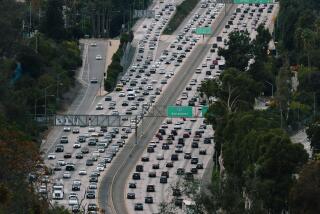Traffic Prompts Inglewood Parking Ban : Regulation: City tries a temporary plan that prohibits leaving cars on Prairie Avenue, which has seen 5,100 more vehicles per day since the Century Freeway opened. Merchants say the restriction will hurt business.
- Share via
For years Inglewood officials looked forward to the opening of the Century Freeway, saying it would be a boon to a community that depends on hundreds of thousands of visitors for its economic well-being.
The city boasts two major hospitals, as well as Hollywood Park Race Track and the Great Western Forum, home to the NBA’s Lakers and the NHL’s Kings.
But since the freeway opened in October, Inglewood and other cities along its 17.3-mile route between Los Angeles International Airport and Norwalk have found that with economic promise comes traffic congestion.
Traffic along Prairie Avenue, one of Inglewood’s major north-south business corridors, has increased 14%, from 37,400 cars a day to 42,500, according to city traffic engineer Parviz Koupai.
“We have a capacity problem now,” he said.
To alleviate the congestion, the city plans to experiment with a curbside parking ban along Prairie beginning Saturday. The ban will end Feb. 15, when city officials will evaluate its impact.
But some merchants along Prairie do not have parking lots and are worried that a permanent ban will hurt their businesses.
“People are going to see ‘No parking anytime’ and they’re going to keep going,” said Sam Hoggard, who owns a hardware store at Prairie and 103rd Street.
Hoggard said he already has a hard time making parking available for his customers because the employees of neighboring merchants take up space on the street in front of his store.
Fabiola Lacayo, manager of the Ronda Beeper store, added that if the parking ban becomes permanent, the business may have to relocate. Lacayo said she would regret moving. “All the people know us here,” she said.
Traffic crews have not measured the flow of cars along Crenshaw Boulevard, Inglewood’s other north-south road with a freeway interchange. But Koupai said, “My hunch is that it has increased also.”
Koupai said he and other officials knew that they might have a traffic problem along Prairie because it runs north from the freeway toward dense residential areas. For commuters anxious to avoid the crowded San Diego Freeway, especially the stretch adjacent to LAX, Prairie serves as an easy route into Baldwin Hills and Culver City.
Until the freeway opened, Koupai said, commuters were traveling through the city via one of Inglewood’s three major east-west streets, Imperial Highway and Manchester and Century boulevards. All three streets link the Harbor and San Diego freeways.
Officials in Hawthorne and El Segundo, the two other South Bay cities that have Century Freeway interchanges, say there has been no increase in traffic since the opening of the freeway, which is officially known as the Glenn M. Anderson (105) Freeway.
The freeway ramps into Hawthorne and El Segundo, which do not lead to large residential areas, are counted on to attract business development.
At the eastern end of the freeway, residents in Downey, Lynwood and Norwalk are complaining about increased traffic on surface streets.
In Downey, scores of cars flood Bellflower Boulevard at rush hour, forcing drivers to wait through up to four cycles of an oh-so-slow traffic light before it hits green. Officials say rush-hour traffic along Bellflower was light before the freeway opened.
In Lynwood, the city’s only freeway exit--Long Beach Boulevard--is becoming increasingly congested, and commuters are clogging tiny residential streets to the south in an effort to escape the crush.
And in Norwalk, where the highway ends at the San Gabriel River (605) Freeway, hundreds of motorists opt for nearby surface streets each evening to avoid the huge backups caused by the timed off-ramp signal that lets just three cars through at a time.
Times staff writer Jill Gottesman contributed to this story.
Freeway Impact
Traffic along Prairie Avenue, one of Inglewood’s major north-south business corridors, has increased 14% since the Century Freeway (105) opened in October.
Source: California Department of Transportation
More to Read
Sign up for Essential California
The most important California stories and recommendations in your inbox every morning.
You may occasionally receive promotional content from the Los Angeles Times.










